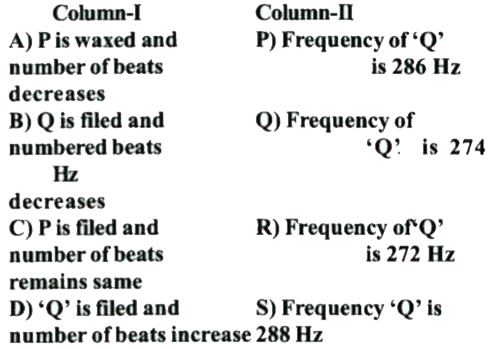Tuning fork F1 has a frequency of 256 Hz and it is observed to produce 6beats/second with another tuning fork F2. When F2 is loaded with wax, it still produces 6beats/sec with F1. The frequency of F2 before loading was
253 Hz
262 Hz
250 Hz
259 Hz
The correct Answer is:B
Step by step video, text & image solution for Tuning fork F_1 has a frequency of 256 Hz and it is observed to produce 6 beats//second with another tuning fork F_2. When F_2 is loaded with wax, it still produces 6 beats//sec with F_1. The frequency of F_2 before loading was by Physics experts to help you in doubts & scoring excellent marks in Class 11 exams.
Topper's Solved these Questions
- BOOK - CENGAGE PHYSICSCHAPTER - SUPERPOSITION AND STANDING WAVESEXERCISE - Fill in the Blanks Type34videos
SUPERPOSITION AND STANDING WAVES
- BOOK - CENGAGE PHYSICSCHAPTER - SUPERPOSITION AND STANDING WAVESEXERCISE - Subjective Type1videos
SUPERPOSITION AND STANDING WAVES
- BOOK - CENGAGE PHYSICSCHAPTER - SUPERPOSITION AND STANDING WAVESEXERCISE - Multiple Correct Answers Type5videos
SUPERPOSITION AND STANDING WAVES
- BOOK - CENGAGE PHYSICSCHAPTER - SOUND WAVES AND DOPPLER EFFECTEXERCISE - Integer16videos
SOUND WAVES AND DOPPLER EFFECT
- BOOK - CENGAGE PHYSICSCHAPTER - THERMODYNAMICSEXERCISE - 241videos
THERMODYNAMICS
Similar Questions
The frequency of tuning fork 'A' is 250Hz. It produces 6 beats/sec, when sounded together with another tunning fork B. If its arms are loaded with wax then it produces 4 beats/sec. Find the frequency of tuning fork B.
View SolutionA tuning forks when sounded together produce 3 beats per second, when sounded with another tuning fork B. when prongs of B are loaded with 1 g of wax, the number of beats become 3 per second. What is the frequency of B ?
View Solution
Knowledge Check
- Question 1 - Select One
Turning fork A of frequency 305 Hz produces 5 beats s−1 with another turing fork B. After filling tuning fork B, it produces 3 beats s−1 with A. The frequency of B before filling was
A300 HzB313 HzC310 HzD308 Hz - Question 2 - Select One
Tuning fork A of frequency 205 Hz produces 5 beats/sec with another fork B. After filing the tuning fork B, it produces 3 beats/sec with A. What was the frequency of the fork B before filling?
A310 HzB313 HzC308 HzD300 Hz - Question 3 - Select One
A tuning fork A produces 4 beats/sec with another tuning fork B of frequency 320 Hz . On filing the fork A , 4 beats/sec are again heard. The frequency of fork A , after filing is
A324 HzB320 HzC316 HzD314 Hz
A tuning fork A, marked 512 Hz, produces 5 beats per second, when sounded with another unmarked tuning fork B. If B is loaded with wax, the number of beats is again 5 per second. What is the frequency of tuning fork B when not loaded?
View SolutionA tuning fork of frequency of 512Hz when sounded with unknown tunning fork produces 5 beats/sec. If arms of the unknown fork are filed then it produces only 3 beats/sec. Find the frequency of unknown tunning fork.
View SolutionFrequency of tuning fork A is 256 Hz. It produces 4 beats/second with tuning fork B. When wax is applied at tuning fork B then 6 beats/second are heard. Frequency of B is :-
View SolutionA tuning fork 'P' of frequency 280Hz produces 6 beats/s with unknown tuning fork 'Q'
 View Solution
View SolutionTwo tuning forks A and B are sounded together and it results in beats with frequency of 4 beats per second . When A is loaded with wax, they again produces 4 beats per second . If frequency of A is 256 Hz, then the frequency of B is
View Solution

